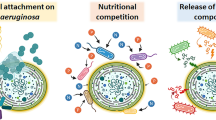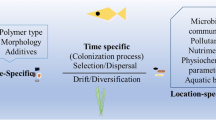Understanding microbial food web dynamics is complicated by the multitude of competitive or interdependent trophic interactions involved in material and energy flow. Metabolic inhibitors can be used to gain information on the relative importance of trophic pathways by uncoupling selected microbial components and examining the net effect on ecosystem structure and function. A eukaryotic growth inhibitor (cycloheximide), a prokaryotic growth inhibitor (antibiotic mixture), and an inhibitor of photosynthesis (DCMU) were used to examine the trophodynamics of microbial communities from the tidal creek in North Inlet, a salt marsh estuary near Georgetown, South Carolina. Natural microbial communities were collected in the spring, summer, and fall after colonization onto polyurethane foam substrates deployed in the tidal creek. Bacterial abundance and productivity, heterotrophic ciliate and flagellate abundance, and phototrophic productivity, biomass, and biovolume were measured at five time points after inhibitor additions. The trophic responses of the estuarine microbial food web to metabolic inhibitors varied with season. In the summer, a close interdependency among phototrophs, bacteria, and protozoa was indicated, and the important influence of microzooplanktonic nutrient recycling was evident (i.e., a positive feedback loop). In the fall, phototroph and bacteria interactions were competitive rather than interdependent, and grazer nutrient regeneration did not appear to be an important regulatory factor for bacterial or phototrophic activities. The results indicate a seasonal shift in microbial food web structure and function in North Inlet, from a summer community characterized by microbial loop dynamics to a more linear trophic system in the fall. This study stresses the important role of microbial loops in driving primary and secondary production in estuaries such as North Inlet that are tidally dominated by fluctuations in nutrient supply and a summer phytoplankton bloom.
Similar content being viewed by others
Author information
Authors and Affiliations
Rights and permissions
About this article
Cite this article
DeLorenzo, M., Lewitus, A., Scott, G. et al. Use of Metabolic Inhibitors to Characterize Ecological Interactions in an Estuarine Microbial Food Web . Microb Ecol 42, 317–327 (2001). https://doi.org/10.1007/s00248-001-0004-1
Received:
Accepted:
Issue Date:
DOI: https://doi.org/10.1007/s00248-001-0004-1




